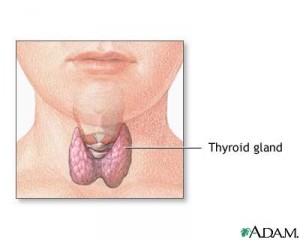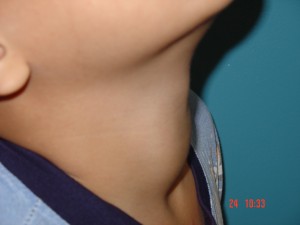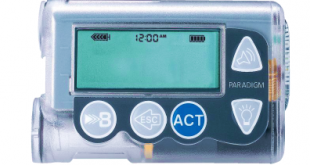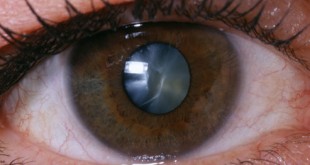- Thyroid disease
Illustration 1 : Thyroid gland situated in front of the neck.
(source : http://health.allrefer.com/pictures-images/child-thyroid-anatomy.html )
Type 1 diabetes mellitus is an antibody-related (autoimmune) disease. Children with type 1 diabetes mellitus can also develop other autoimmune diseases. One of the most common associated autoimmune conditions is thyroid disease.
The thyroid gland is a butterfly-shaped gland situated in the front part of the neck (see illustration 1). It produces thyroid hormone which is important to maintain normal body metabolism and functioning.
Children and adolescents with type 1 diabetes mellitus are more prone to get antibody-related (autoimmune) thyroid disease. The more common autoimmune thyroid disease is underactive thyroid not producing enough thyroid hormone. It occurs in about 3-8 % of children and adolescents with type 1 diabetes. Less commonly found is overactive thyroid producing too much thyroid hormone. In both conditions, the thyroid gland can be enlarged appearing as a neck swelling (photograph 1).
Photograph 1 : Neck swelling
In those with underactive thyroid (hypothyroidism), the doctor may detect the following symptoms and signs :
- lethargy
- weight gain without increased food intake
- constipation
- poor growth
- cold intolerance
- slow heartbeat
- deteriorating school performance
Often these symptoms may not be noticed by the child or the parents.
Those with too much thyroid hormone (hyperthyroidism) can have the following symptoms and signs :
- palpitations ( heart beating fast)
- agitation
- loss of weight without loss of appetite (in fact may have increased appetite)
- diarrhoea
- nervousness
- heat intolerance (feelings of warmth)
- sweaty and shaky hands.
- Some may also have unexplained difficulty in diabetes control and protruding eyes.
Both conditions need blood tests to confirm and can be treated with medications in the form of tablets.Those with underactive thyroid problem need to receive long-term thyroid hormone replacement.
As symptoms caused by thyroid problem may not be obvious or can be absent, a screening blood test is recommended to detect any thyroid problem every 2 years in children and adolescents with type 1 diabetes who otherwise have no features or complaints of thyroid problem.
Children and adolescents with type 2 diabetes are not more prone to having thyroid problem.
- Coeliac disease
Coeliac disease (intolerance to gluten) occurs in 1-10% of children and adolescents with type 1 diabetes. However, this condition is rare in our population compared to thyroid disease. It is another antibody-related (autoimmune) disease in which the body forms antibodies against the protein gluten found in grains wheat, barley, oats and rye. These antibodies damage the gut lining causing poor absorption of food leading to multiple nutrient deficiencies. As adequate nutrition is important for a child to grow normally, coeliac disease can cause poor growth in children.
Coeliac disease can cause tummy ache, bloating, constipation or diarrhoea and sometimes anaemia (link to anaemia). Many do not have symptoms and a blood test can be done to detect the disease. A gut biopsy (take a small sample of gut tissue) is needed to confirm the disease. It is best managed by avoiding all food containing gluten.
Children and adolescents with type 2 diabetes are not more prone to having coeliac disease.
- Other autoimmune diseases
Children and adolescents with type 1 diabetes can also develop other less common associated autoimmune diseases involving the skin and adrenal glands.
Vitiligo is a disease of the skin whereby there is loss of cells producing pigments (melanin) in the skin. As a result there are white spots on the skin. Treatment is often difficult.
Adrenal glands are a pair of small glands situated on top of the kidneys. Adrenal glands produce chemical substances called hormones in the body which are important to maintain normal body functions especially in dealing with infections and body injury.
Addison’s disease is a disease whereby the adrenal glands are not producing enough hormones. There is deficiency of hormone named cortisol. It can occur in children and adolescents with type 1 diabetes. Addison’s disease can cause frequent hypoglycaemia (low blood sugar), tiredness, loss of weight, vomiting and abnormal electrolyte (sodium and potassium) levels in the blood. Blood tests are done to confirm the disease. It is treated with lifelong adrenal hormone replacement.
Children with type 2 diabetes are not more prone to having other autoimmune diseases.
- Growth impairment
Children and adolescents with poor diabetes control can develop growth retardation and abnormal puberty development. Puberty is the process of developing male or female physical body characteristics in the teenage years. In growth retardation, the child’s weight and height do not increase accordingly. All children with diabetes have their weight, height and puberty monitored until growth and pubertal development are complete which is usually by late teenage years.
- Infections
Children and adolescents with diabetes mellitus are more prone to getting infections in the skin and urinary tract (kidney and bladder) especially when diabetes is poorly controlled with persistent high blood sugar level. Skin infections can be caused by bacteria as in boils and abscess.
Fungal infections can also occur on the skin and genitalia. Fungal infections of the vagina in girls cause itchiness and whitish flaky discharge.
It is important to keep the skin clean and practice good personal hygiene to prevent these infections. The infection needs to be treated early and adequately besides improved blood glucose control.
- Limited Joint Mobility
Limited joint mobility occurs in children with type 1 diabetes and can involve joints in the hand and fingers (see photograph 2), wrists, elbows, ankles and spine. It is a painless condition with joint contractures associated with tight waxy skin. The reduction in joint movement usually does not cause much problem in the joint function. Therefore, there is no significant disability.
Photograph 2 : Limited joint mobility (Prayer’s sign)
References
- Kordonouri O, Maguire A.M, Knip M, Schober E, Lorini R, Holl R.W, Donaghue KC. (2011). Other complications and associated conditions associated with diabetes in children and adolescence. In Global IDF/ISPAD Guideline for Diabetes in childhood and adolescence (Chapter 18, pp.123). Retrieved February 4, 2013, from http://www.idf.org/global-idfispad-guideline-diabetes-childhood-and-adolescence
- Associated diseases. Type 1 diabetes in children, adolescents and young adults. Dr Ragnar Hanas 2nd edition. Chapter 33, page 300-302 .
- Photograph 2 (courtesy of Stuart Brink) from Practical Paediatric Endocrinology in a limited resource setting. Editor Margaret Zacharin. Page 223.
 PENDIDIKAN PESAKIT Kementerian Kesihatan Malaysia
PENDIDIKAN PESAKIT Kementerian Kesihatan Malaysia






